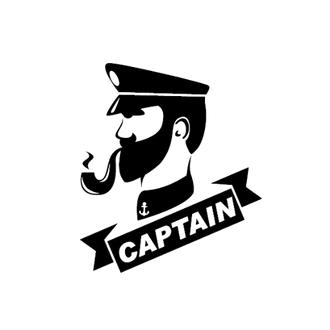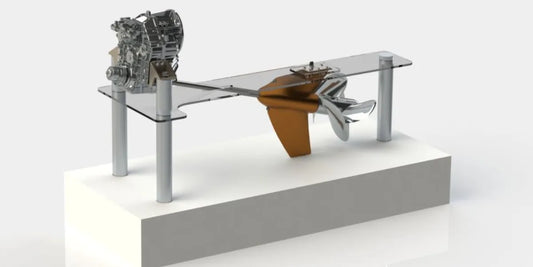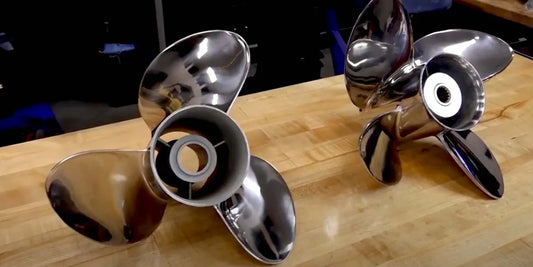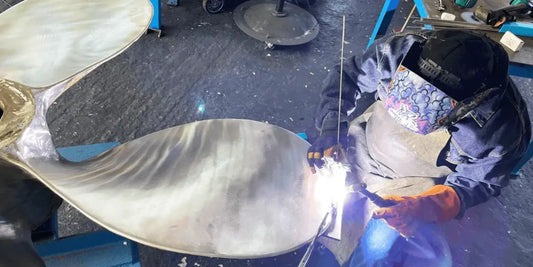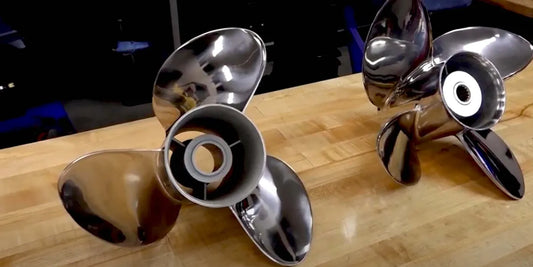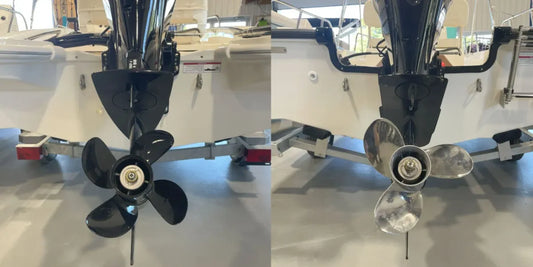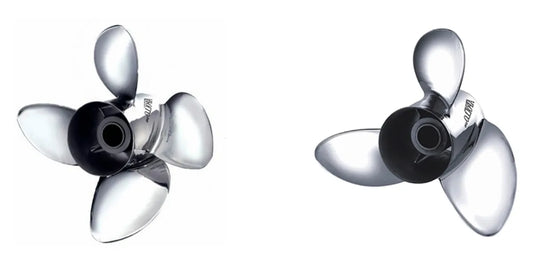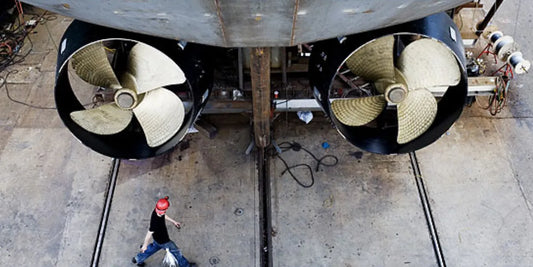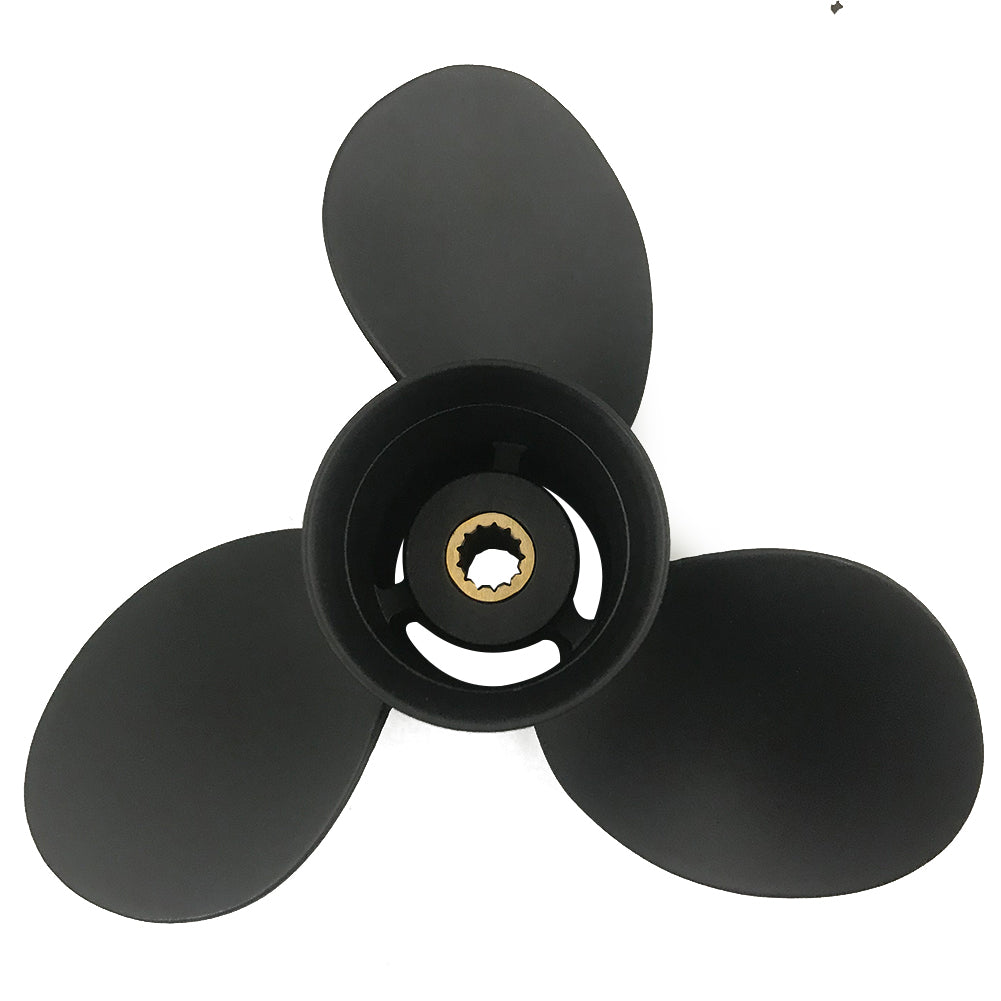Performance on water relies heavily upon underwater equipment, and very few propellers can carry the most significant weight of speed, acceleration, and handling. This article provides the reasoning behind why stainless steel boat propellers might be the top option for those seeking a genuine performance enhancement in their marine venture. Whether it's longevity, fuel savings, or outright top speed in rough conditions, stainless steel propellers offer certain unique benefits. Follow along as we discuss some of these benefits and help you understand why an upgrade to stainless steel might be the right choice to make your boat stand out.
Understanding Boat Propellers

What is a Boat Prop?
Known simply as a "prop," the boat propeller is the essential component of a vessel's propulsion system. It converts the rotational power generated by the engine into thrust, enabling the boat to move through the water. Usually found and fitted on the stern of the boat, a propeller consists of a central hub surrounded by blades, and these blades are set at an angle so that they push water backward as they rotate. The reaction force of this backward thrust provides the boat with its forward motion, by Newton's third law of motion. This signifies that the design, material, and working of the propeller hugely influence the performance, speed, and efficiency of the boat.
Boat props differ significantly in materials, number of blades, pitch, and diameter. Aluminum and stainless steel are commonly used; stainless steel gives superior performance and durability. The number of blades is another significant consideration; the most common designs are the three- and four-blade models. By way of explanation, a three-blade propeller is most commonly used when top speed is desired; four-blade propellers generally provide better control and smoother operation in rough water. Finally, pitch refers to the distance that a propeller should theoretically move through the water in one complete revolution. It directly affects acceleration and top speed.
Understanding the features and functions of a boat propeller is imperative to any owner or enthusiast. You will want to choose the appropriate type of propeller for your boat to allow it to perform optimally, depending on whether your goal is fuel efficiency, improved handling, or increased speed, considering factors such as strength, weight, and resistance to wear in a wide range of water conditions. The material and design factors, combined with the engine specifications and intended use of your boat, will lead you to the proper propeller selection. An ideally suited boat propeller will not just be able to bring forth a necessity but also give you a whole new, pleasurable boating experience.
The Importance of Propeller Design
The actual design of a propeller is a critical factor that determines the boat's performance. Variables that affect the efficiency of a propeller in transferring power from the engine to thrust include blade shape, pitch, diameter, and the number of blades. The larger diameter propellers would indeed provide more thrust at lower speeds and, hence, might be preferred by heavier boats. A propeller having a higher pitch would be chosen for higher speeds by the lighter boats. However, considering the demand for performance is somewhat equivocal, a boat owner may want to consider these design factors when selecting propellers for better suitability in various applications, such as towing, cruising, or racing.
Recent technological advancements have given rise to enhanced propeller designs that emphasize greater efficiency and durability. Modern materials, including stainless steel and aluminum, have been selected to strike a balance between strength, weight, and resistance to wear in various water conditions. Furthermore, advanced blade geometries such as cupped edges and progressive pitch exist to minimize cavitation and maximize fuel efficiency. Results from multiple studies have demonstrated that optimizing propeller design has the potential to reduce fuel consumption by approximately 10 percent while simultaneously improving maneuverability and acceleration. Observing these design considerations ensures optimum on-water performance and increased enjoyment for the boater.
Types of Boat Propellers: Stainless Steel Vs Aluminum.
When it comes to the choice of boat propellers, stainless steel and aluminum propellers remain the two options that can be compared on merit, a standard by which boats vary in their requirements. Stainless steel propellers, wear, and performance are parallel in excellence. They resist corrosion the most, and deformation hardly occurs under high stress; therefore, they are the best choice for top-speed or performance applications. Their strength allows for thinner blades, thereby increasing the hydrodynamic efficiency of the propeller and enhancing its top speed performance. However, these propellers, made of stainless steel, are expensive and would be a better investment for serious boat owners in the long run.
On the other hand, aluminum propellers are less heavy, less costly, and most readily available; this makes it suitable for casual or recreational boating. It is easier to repair in case of damage, as aluminum is a less rigid material. Although aluminum propellers may not offer the same performance level as stainless steel, in shallow waters where accidental hits are more common, they would be an ideal choice to consider. Both have their usage scenarios. The selection between them usually depends on the boating environment, expected performance, and price consideration of the boater. Understanding the pros and cons of stainless steel and aluminum propellers will help boaters make an informed choice for their specific needs.
Benefits of Stainless Steel Propellers

Durability and Strength
Among the key distinctive features that contribute to stainless steel propellers being more durable and strong, thus making them a preferred choice for most boat lovers. In comparison, aluminum is a less dense and softer material that does not wear as well with use. Stainless steel, with its added strength, possesses the properties to resist bending or cracking occasioned by the cosmos or debris from the underwater or stiff water conditions. The ruggedness of stainless steel ensures a more reliable performance and lasts for any boaters operating in these rugged environments, including rocky or shallow waters.
Another feature of stainless steel is its exceptional corrosion resistance. Stainless steel properties allow it to resist corrosive elements and saltwater. This means that stainless steel propellers maintain their integrity and appearance even after prolonged exposure to marine conditions. The corrosion resistance reduces maintenance and adds value to the boat owners who want a propeller that can be preserved over time. While stainless steel propellers may come at a higher price than aluminum ones, their superior strength and longer service life may be a counterbalancing payoff. For anyone seeking top-performance and reliability solutions, stainless steel stands as the primary choice in the propeller world.
Performance and Efficiency
In addition to unparalleled durability, stainless steel propellers are also credited with improved performance and efficiency in the water. Rigid structures and superior design of stainless steel propellers enable a more efficient power transfer from the engine to the water, thereby increasing speeds, accuracy, and control. The structural advantages of stainless steel become particularly evident in high-performance boating or situations requiring quick acceleration and high maneuverability. Stainless steel assures no flexing under pressure and consistent performance when running at higher speeds or in adverse marine conditions.
The design versatility of stainless steel propellers further enables boaters to fine-tune the response according to specific boating applications. Many models offer advanced blade geometries and customization capabilities, enabling more efficient fuel consumption and superior handling. Efficient use of fuels is a crucial factor in ensuring optimal performance while reducing operational costs over time. The advantages in fuel efficiency provided by stainless steel propellers complement the activities of boat operators, whether they are cruising on calm lakes or navigating rough coastal waters, thereby creating an overall better boating experience while also reducing fuel emissions due to lower fuel consumption.
Furthermore, stainless steel's strength and efficiency make it the number-one option among competitive boaters and casual users. It is a significant initial investment, as boaters can rely on consistent results from stainless steel propellers in a wide array of applications. Stainless steel propellers go hand in hand in providing maximum engine output with quiet and sensitive control, blending performance with efficiency; these factors rank it as one of the top marine propulsion options available.
Corrosion Resistance in Marine Environments
A marine environment is a special case, as it exposes materials to water and salt, variable temperatures, and fluctuating humidity, all of which accelerate corrosion. Stainless steel propellers are genuinely known and appreciated for their utmost corrosion-resisting properties, based on the very nature of the material. The chromium contained in stainless steel forms a passive layer of chromium oxide on the surface, preventing corrosion from attacking the metal. The marine-grade variants of stainless steel, with higher traces of nickel and molybdenum, further enhance their ability to withstand pitting and crevice corrosion from saltwater.
A study indicates that stainless steel, which outlives other materials in corrosive environments, significantly reduces maintenance costs and extends the service life of marine-borne equipment. For example, propellers made of stainless steel are far more resilient in existence than those made using aluminum or other materials, particularly in the most demanding operating environments. This enhanced ability to resist corrosion will go a long way toward giving assurance of long-term performance. It, therefore, makes stainless steel a very worthy investment for long-term service. In addition to its resistance to corrosion, it also offers resistance to fouling, stemming from underwater organisms. Propellers stay clean and remain stiffly on their feet under all conditions, extending efficiency beyond the due period.
Choosing the Right Outboard Propeller

Understanding Propeller Pitch and Diameter
The two factors of most significant concern to the buyer when assembling an outboard motor are probably pitch and diameter. Pitch in propellers is the distance the propeller can move forward in one rotation without considering any slip. For example, a 15-inch pitch prop moves theoretically forward 15 inches with one revolution. A lesser pitch allows the engine to reach higher speeds very quickly, which is ideal for bearing heavier loads or towing. In contrast, a greater pitch would offer greater speed by covering more distance per revolution, but may compromise lower-end performance.
The diameter of a propeller is the diameter of the circle described by the rotating blades. Larger diameters would create more thrust, which would be necessary for heavier boats or rough waters. In contrast, smaller diameters are more suitable for lighter crafts or high-speed applications, as they create less drag in the water.
A compromise between pitch and diameter is needed to maximize engine efficiency and adapt the propeller to the size of the boat and its specific application. For instance, any buoyancy-carrying heavier weight should have propellers of low pitch and large diameter for better handling and acceleration. At the same time, anything intended for speed would have a higher pitch and a slightly smaller diameter to reduce resistance and optimize performance.
Generally speaking, best practice aligns propeller specs with the engine manufacturer's specifications and the boat's performance requirements to provide the smoothest ride on the water, faster planing times, and lower fuel consumption, thereby creating the best onboard experience.
3-Blade or 4-Blade Propellers?
Performance, efficiency, and handling are compromised when either 3 blades or 4 blades are chosen. A 3-blade propeller typically prioritizes speed and efficiency, offering less drag and improved top-end performance. In rare cases where maximum speed is required, this is the option of choice, especially for lightweight boats operating in open waters.
In contrast, four-blade propellers offer better handling, stability, and acceleration. The extra blades create more lift, combining smooth operation with the conditions of rough water. Thus, they are preferred for towing, fishing, or choppy waters, as they mitigate grip and vibration from the boat driver's perspective. Also known are four-blade propellers, which are more fuel-efficient at slow speeds, making them apt for applications requiring consistent thrust and smooth control.
Some key performance differences are in holeshot and cruising efficiency. For example, 4-blade propellers usually have an upper hand in the holeshot; hence, they are great for water sports, while 3-blade propellers excel at hitting the top speed. The deciding factor boils down to the actual use of the boat, and 3-blade propellers are generally used in situations requiring forceful speed, while 4-blade propellers support stability and maneuverability. A thorough evaluation of your boat's design and performance objectives will determine the best fit for an enhanced boating experience.
OEM or Aftermarket?
The choice of propeller will have a significant effect on how well the boat performs and the price you pay for the product scope. OEM stands for Original Equipment Manufacturer. Therefore, these propellers are designed by the manufacturers of your particular boat or motor, ensuring exact compatibility with assured standard performance and consistency according to the manufacturer's specifications. OEM propellers are probably the most used by people who value indisputable quality and lasting performance.
In contrast, aftermarket propellers are produced by third parties and hence offer a much broader range of options than those provided by manufacturers. These provide you with the option to customize the performance of your equipment under specific conditions or as an economical replacement. Many aftermarket brands utilize more cutting-edge materials, such as stainless steel alloys, to enhance durability and achieve a competitive performance that rivals OEM alternatives. Some models were entirely innovatively designed, so those designs are applied to increase speed, fuel economy, or handling.
The decision of whether to mount an OEM or aftermarket propeller will rest on personal preferences, such as budget, need for customization, and overall performance goals. Those who want to customize their boats might favor the variety and versatility of aftermarket selections. At the same time, those who require reliability that matches original specifications might prefer an OEM propeller. A differential analysis of compatibility, warranty, and grade of materials will guarantee a trade-off chosen fits the need of your boat.
Popular Brands and Models

Mercury Stainless Steel Propellers
Mercury stainless steel propellers are renowned for their exceptional durability, outstanding performance, and meticulous engineering. These propellers are designed to deliver maximum thrust and fuel efficiency, serving the demands of recreational, competition, and commercial boating. Their most significant advantage is that they are made of corrosion-resistant material, which provides long life in the harsh marine environment. Available in various configurations, Mercury stainless steel propellers can be combined to suit several types of engines and water conditions, providing performance and leisure for boats of varying bases.
The Mercury Enertia and Rev4 products, for example, also stand to improve hole shot and top-end speed. The Enertia utilizes a revolutionary X7 alloy, making it lighter and stronger than traditional stainless steel, which further enhances acceleration and fuel economy. In contrast, the Rev4 is the choice for heavy boats and rough waters, increasing handling and gripping in sharp turns.
Some other factors to consider when purchasing a Mercury stainless steel propeller include pitch, diameter, and rotation that complement the engine and the type of boat in question. Most models include all the advanced features that, with fins, reduce ventilation and improve efficiency at high speed. This blend of technological advancement with ultra-tight manufacturing precision is why Mercury propellers remain the reliable and high-performance choice of any boater.
Yamaha Outboard Propeller Choices
Equipped with an impeccable reputation for versatility and innovation, Yamaha outboard propellers have become the first choice in varied types of boating applications. These propellers come in various configurations to fit dozens of engine models and watercraft types, thereby achieving optimal performance on the water. Among the features of the Yamaha propellers are corrosion-resistant materials, a precision-engineered design, and advanced blade geometry, all geared toward improving thrust and fuel efficiency.
The Saltwater Series II Stainless Steel propellers, manufactured by Yamaha, for instance, are designed to cater to offshore boating needs, offering superb acceleration and mid-range performance. Lightweight, the Reliance Series is best suited for mid-sized boats, offering speed and handling. Yamaha also markets aluminum propellers as an economical alternative that provides fair durability and performance for leisure and small-scale commercial boating operations.
Selecting an appropriate Yamaha propeller entails considering pitch, diameter, and intended use. If improving stability at speed or towing capabilities is the goal, Yamaha Ventless Propellers, which drastically reduce ventilation while remaining smooth under heavy loads, are an excellent choice. Such propellers are quintessential of Yamaha's devotion to top-quality and innovation, so that every boater has a tailored solution for their very own needs.
Solas and Other Leading Brands
Solas claims to manufacture premier propellers with high-tech materials and tools. Being known for durability and performance, Solas propellers range to almost all kinds of civil and commercial boating applications—their designs center on improving efficiency and performing reliably from one water condition to another.
The best brands, however, were condemning the sale of such propellers, as seen with Mercury Marine and Michigan Wheel, which ostensibly focus on thrust optimization, drag minimization, and fuel efficiency. Mercury Marine, for instance, markets new-age propellers, including Enertia and Bravo series, designed for precise handling at high speeds. Michigan Wheel has always emphasized custom-made designs, offering expert advice on selecting the right match for vessel type and engine performance.
These brands represent innovation and engineering excellence, offering boaters the broadest range of options to meet their specific needs. When it comes to performance, fuel efficiency, or long-term reliability, these brands deliver products that enhance the overall boating experience.
Buying Guide for Stainless Steel Boat Propellers

Where to Buy: Distributors and Online Retailers
With the advancement of technology, many stainless steel boat propellers have been manufactured and marketed through a large number of trusted dealers, ranging from independent marine stores to online retailers. Local dealers are always a good option if you value a personal touch and professional guidance. These experts can advise you on the best propeller for your vessel, which will be compatible with your engine and meet the required performance specifications. Additionally, buyers typically prefer to see the propeller in person or ask questions about its installation and maintenance when purchasing from a local dealer. In cases of trouble, most dealers can offer installation or after-sales support.
The online store offers convenience and a wider range of choices for sellers. Major marine specialty e-commerce sites typically maintain extensive inventories of stainless steel propellers manufactured by reputable companies and offer them at competitive prices. By providing online shopping comparison and review-free sites with detailed specifications, you can make purchases from the comfort of your own home. Besides this, major online stores also offer significant advantages, such as speedy shipping, easy return policies, and an active customer support program that makes the buying experience a joy.
Ultimately, whether you choose to buy from a local dealer or an online retail portal depends on your specific preferences and requirements. If you consider that hands-on advice by design from a professional and installation service will be carried out immediately, then a dealer would better satisfy your needs. However, conversely, if you are looking for simple one-day rolling closed shopping, are comfortable during 24 hours, or need a wider variety of product catalog, then you ought to begin by trying online platforms to lead you to the perfect stainless steel prop for your boat.
Essential Factors to Consider in the Upgrade
While upgrading, I consider several essential factors to ensure that the new purchase meets my requirements and expectations perfectly. I always think about the performance requirements of my boat. The size, weight, and engine type are all significant factors when selecting the right propeller upgrade for me. Do I gain from increased speed and fuel efficiency, or smooth and quiet handling? Then, the material of the propeller is also another essential consideration. Stainless steel, for example, is tough and more challenging to break, and is designed to withstand adverse conditions, making it an excellent choice for long-term investment.
Then, my preference goes for the pitch and diameter specifications. These factors greatly affect how the boat handles on different occasions, such as in rough waters or while towing. A high pitch might mean that your ship can go faster; however, an inappropriately matched pitch places a strain on the engine. Thus, I try to balance what works best with my plan of usage, whether I will be cruising casually, taking a fishing trip, or engaging in watersports.
Lastly, there is just the cost and value of the upgrade. Although the cheap option can be pretty attractive, I consider the lifespan and efficiency of the propeller. Buying a better product means fewer chances for replacements, which improves my whole experience. I also think the warranty or service support provided by the manufacturer is beneficial when issues arise. By carefully considering these factors, I will feel confident in my first step.
Tips for Installing Outboard Propellers
Outboard propeller installation can seem daunting; however, following the correct procedures makes it a relatively simple process. Preparing all the necessary tools before the installation typically includes a socket wrench, pliers, and a small amount of marine grease for lubrication. Removing the old prop would be one of the first steps, which involves straightening the cotter pin and removing it, followed by undoing the prop nut. I would never neglect to check the propeller shaft for any damage or deposits before installing the new propeller, as a clean and undamaged shaft ensures better performance and reduced wear on the new propeller.
With the shaft cleaned and prepared, slide the new propeller onto the shaft, taking care to ensure it does not damage the splines. Marine grease is applied to the shaft before installation, which helps prevent corrosion and also facilitates removal in the future. After the propeller is in place, the prop nut should be tightened firmly but not excessively, as over-tightening can cause problems. The cotter pin is then reinserted and bent around to lock the assembly in place. After completion, a double-check ensures nothing is loose before going out onto the water.
Once installation is complete, I am assured that my boat is fitted for the best possible performance. I make it a habit to check in on the propeller every now and then after installation to ensure that it is functioning as it should and that no issues have arisen. I can confidently perform outboard propeller installation with ease by taking my time and observing these installation steps.
Reference Sources
-
Prop Bites: How To Choose Between Aluminum and Stainless Steel Props - Mercury Marine
This article explains the performance and durability advantages of stainless steel propellers over aluminum ones. -
Upgrade to Stainless Steel Prop? Worth it? - The Hull Truth
A discussion on the benefits of stainless steel props, including improved fuel economy, speed, and handling. -
Aluminum vs. Stainless Steel Props: What's the Difference? - Boats.net
A comparison highlighting the rigidity and durability of stainless steel propellers for high-horsepower motors. -
Do You Really Need a Stainless Steel Prop? - HC Boating
This blog explores how stainless steel props improve boat handling and provide a wider trim range. -
Advantages of Steel Props as Opposed to Aluminum - Reddit
A community discussion on the advantages of stainless steel props, especially in saltwater conditions.
Frequently Asked Questions (FAQs)
What are the benefits of stainless steel boat propellers?
Stainless steel propellers have several advantages over aluminum propellers. Stainless steel propellers stand out for their durability and efficiency, making them the prime choice for high-performance use. Simultaneously, such propellers are more resistant to damage from impact, a significant consideration in recreational and commercial boating. Generally, stainless steel propellers also provide better handling and boat performance under various operational limiting conditions. The design and technology applied in these propellers enable the maximization of lift forces while minimizing drag forces, a feature that many boaters seek.
How do I select the correct propeller for an outboard motor?
Choosing the right propeller for an outboard motor depends on several factors- horsepower requirements of the engine, the type of recreation one intends to do, and the weight and design of the boat. Look for propellers for 40 hp engines, or equivalent terms, to find the list of propellers that fit the working range of your outboard. Pay attention to pitch and diameter, as these are the factors that affect your speed and efficiency. Visit a dealer or specialized store and inquire about the type of propeller that would work best for your specific outboard, whether it is a Yamaha, Honda, or Evinrude model. Try several configurations to narrow down the best one for your style and efficiency.
How do stainless steel propellers enhance boat performance?
By achieving better thrust and efficiency than their aluminum counterparts, stainless steel propellers deliver optimal performance in boats. Stainless steel propellers are designed and configured to set the fastest top-end speeds and best acceleration for both recreational and racing applications. The stiffness of the material maintains the blade's shape closest to its designed form under load, thereby enhancing lift and reducing slip. Moreover, stainless steel propellers are available with pitch modifications, enabling them to serve various conditions and purposes. Thanks to this new technology, stainless steel propellers have become the preferred choice among many boaters seeking to upgrade their gear.
Are these a good investment?
Indeed, stainless steel outboard propellers are a worthwhile investment due to their long-term durability and performance enhancements. However, the good performance of stainless steel propellers has a price, being higher than that of an aluminum propeller. Yet, due to their wear and damage resistance, you'll be set for an extended period before needing replacements, which keeps repair costs down. Ultimately, they enhance your outboard engine's power conversion efficiency, allowing you to save fuel while also achieving better performance. For the real boater who fishes and races, stainless steel propellers are the best choice. The upgrade to stainless steel could completely change your boating experience.
How does one maintain stainless steel boat propellers?
Maintaining stainless steel boat propellers is not tricky, but it is essential for achieving optimum performance. Regular inspection of nicks, dents, and possible corrosion is always recommended, as they can lower your propeller's efficiency. Always clean your propeller after every use; doing so will prevent debris collection and salt buildup. Good practice is to check the hub to ensure the propeller is firmly fixed to the outboard engine. It usually means that when you begin to face performance problems, it might be time to consider a replacement or repair. Proper maintenance will extend the life of your stainless steel propeller by many extra years.
Can you put a stainless steel prop on an aluminum outboard?
You can install a stainless steel prop on your aluminum outboard if it can be fitted according to the motor's specifications. A number of potential buyers prefer stainless steel due to its performance benefits, even on engines with below-average horsepower. It is important to match the pitch and diameter of your propeller to your motor's capabilities. Otherwise, you may cause damage or dissatisfaction in its performance. Getting your dealer or manufacturer on board with your selection will help you find the best stainless steel prop for your aluminum outboard. The initiative can substantially improve both the efficiency and performance level of your motor.
